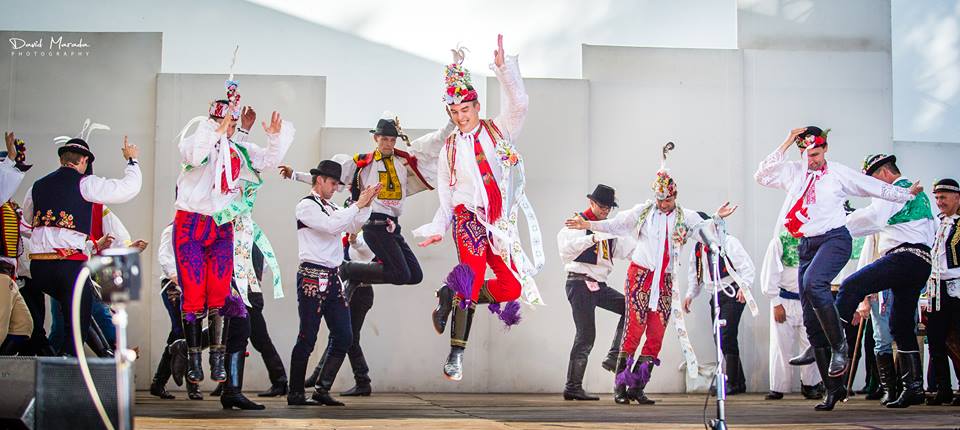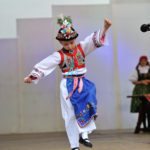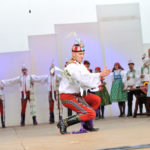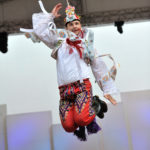UNESCO list: 2005, National list: 2009.
On November 25, 2005, the UNESCO Secretary General declared the Slovácko verbuňk a Masterpiece of the Oral and Intangible Heritage of Humanity. After the Convention for the Safeguarding of the Intangible Cultural Heritage of Humanity was adopted and 30 countries acceded to it, the Masterpieces project was suspended and transformed. The abovementioned Convention established two new lists of elements of the intangible culture – the Representative List of the Intangible Cultural Heritage of Humanity, and the List of the Intangible Cultural Heritage in Need of Urgent Safeguarding.
Reprezentativní seznam - Nominační dokumentace "slovácký verbuňk" verze CZ ENG version
Národní seznam - Nominační dokumentace "slovácký verbuňk"

The Slovácko verbuňk is a male dance of hopping nature. It is an improvised dance. It is special for its character, as despite being danced mostly in a group, each of the dancers dances for himself, expressing where he comes from and his individual dancing skills and nature. Verbuňk is danced with a certain type of songs, the so-called New Hungarian songs prevailing since the second half of the 19th century.
The name of the dance is derived from Werbung, a German word meaning recruiting, hiring, signing up, and from the practice of military service recruitment performed in the Czech lands until 1781 under the participation of professional military dancers, whose expression seems to have been one of the impulses for the creation of the dance.
In the Czech Republic, verbuňk has spread solely in the ethnographic area of Slovácko where it is or was also called with different names – cifra, cifrování, cifruňk, čardáš, čardášování, verbování, skákání, grepčení (grebčení).
Slovácko verbuňk usually consists of three parts: the dance begins with lead singing, whereby the dancer´s motion, if he does not stand in a semicircle together with the others, is very individual; after that, there follow a slow dancing part and then a fast dancing part which is a free motion composition with a very individual atmosphere.
Verbuňk was preceded by lad´s dances as well as other forms of motion, from which it gradually evolved. These forms included competition dances for who jumps higher, an individual male expression in rotating dances, and – probably especially – adorned walking of men in parades and ceremonial door-to-door processions, and maybe even other dances with competition elements. The spread of the new Hungarian songs might have been another impulse. The ethno-choreologists think verbuňk was formed as an independent dance in the second half of the 19th century, and it has evolved into six regional types in the 20th century.
According to the current state of research, it is possible to speak about six types of Slovácko verbuňk:
- from the Strážnice area
- from the Kyjov area
- hanácko-slovácký type from the Hustopeče and Ždánice areas
- „horňácký“ type from the Velká nad Veličkou area
- „uherskohradišťský“ type from the Uherské Hradiště and Uherský Brod areas
- “podlužácký” type from the Břeclav area
Slovácký verbuňk still performs several functions and it features great emotionality which is related to the fact that it is an improvising dance, not bound by strict choreographic rules and therefore giving more space to spontaneity. Originally, dancing this dance, the conscript said goodbye before military service, and compensated the great psychological tension and negative emotions resulting from the forthcoming departure to the military service, though showing simultaneously that he is capable of military service and striving to make an impression on the opposite sex. Therefore the psychological, the competitive and the erotic functions dominated in the dance. The dance was gradually adopted by other male members of the community, too, and the dance was progressively incorporated in other occasions of folk life, acquiring new functions. The ceremonious function became a very important one, then the expressing of the character, the immediate mental and physical condition of the dancer, and his identification with the village or the community.
Currently, the ceremonious function further develops – verbuňk is part of ceremonious parades and the whole complex of the kermes customs. It is danced in the parade of domestic young people, when the stárek is welcome in front of his house; at the beginning and at the end of the kermess dance party each group of boys coming from other villages is honoured by being given an occasion to dance verbuňk in front of all those present. The competitive function has remained preserved as the dancers compare their performances between each other. As a new function, the verbuňk expresses an affiliation to that group of young people who have positive active relation to the heritage of traditional folk culture.
In order to perform verbuňk excellently, the interpreter has to have several skills. Singing and the purity of intonation ranks first, furthermore it is necessary to manage the dialect and use it correctly. A good verbuňk dancer is also assumed to have a good knowledge of the song repertoire, i.e. texts and melodies used at the dance. As regards movement skills, the demanding nature, the number, proper sequence and level of performing dancing elements and figures are important. The dancer has to manage space arrangement, dance composition and gradation. Slovácko verbuňk is a unique expression of human creativity which is manifested by the fact that it has developed into six original regional types at quite a small area that Slovácko (Moravian Slovakia) occupies within Moravia, using the same dancing motifs (jumping up, jumping over, jumping aside, heel steps, heel clicking, stamping, handclapping, knee bending, leg stretching out and backwards, etc.) though usually performed in a different way and with a different intensity, frequency of occurrence, positioning of legs and sometimes also hands and the posture during the dance. These types have been preserved until the present and are further developed. If the dancer wants to be accepted by the community within which he acts, he must observe its regional type and be able to develop it in the spirit of the type. Slovácko verbuňk’s uniqueness consists in its complexity: each dancing performance is actually a unique creation. The dancers themselves perceive verbuňk quite emotively and, as they did in the past, they appreciate excellent verbuňk dancers even these days.
The contests in verbuňk dancing began already at the first festival in Strážnice, however, they ceased to exist after several years. They were renewed only in 1986. The Contest for the Best Dancer of Slovácko Verbuňk begins with regional rounds, its finale takes place at the International Folklore Festival in Strážnice. This Contest enjoys great interests among the visitors to the Festival, and for this reason, a visitor poll is conducted whose winners are mentioned in the following overview.
Winners of the Contest for the Best Dancer of Slovácko Verbuňk
The inscription of Slovácko verbuňk on the list of Masterpieces of the Oral and Intangible Heritage of Humanity is an extraordinary event for the Czech Republic. However, it brings a lot of measures and obligations to which our country obliged in the “action plan” which was an integral part of the nomination. In the archives of the National Institute of Folk Culture, you can find two sets of copies of the documents submitted in Paris (one in English and the other one in the Czech language). The above action plan is supposed to ensure the safeguarding of the Slovácko verbuňk for coming generations. If this is the case, the endeavours and goals of UNESCO, the Ministry of Culture, the National Institute of Folk Culture, and of everybody who took part in the preparation of the nomination, will be accomplished.




